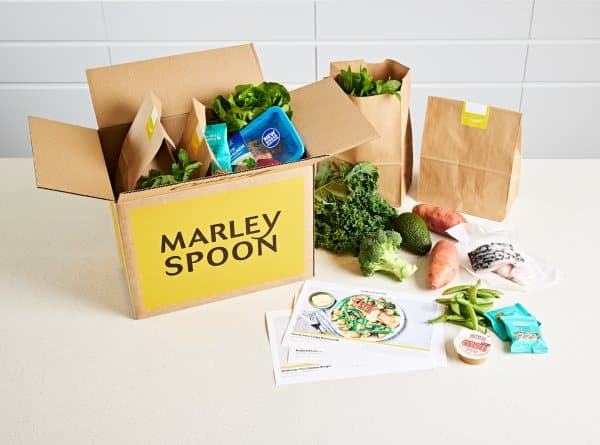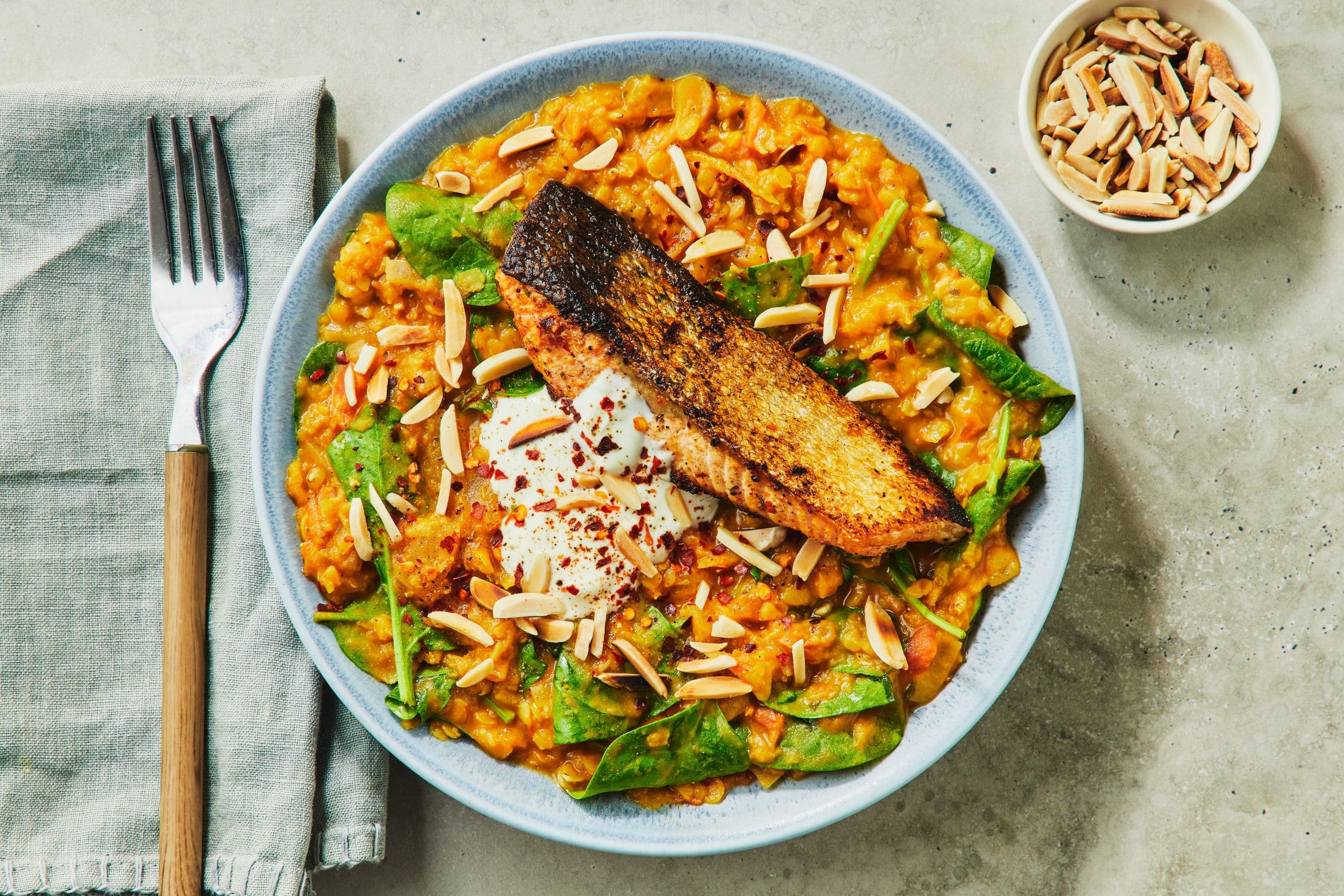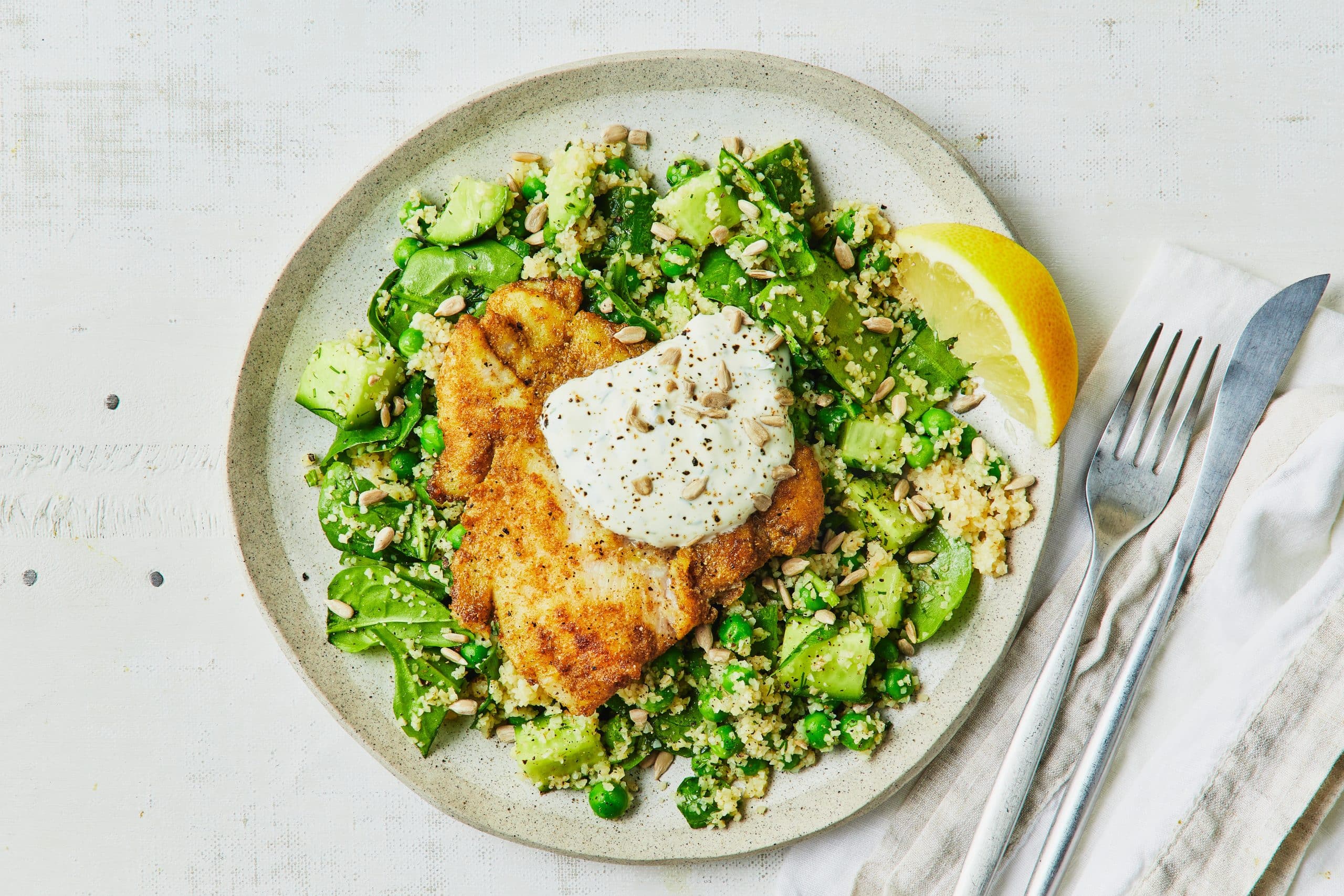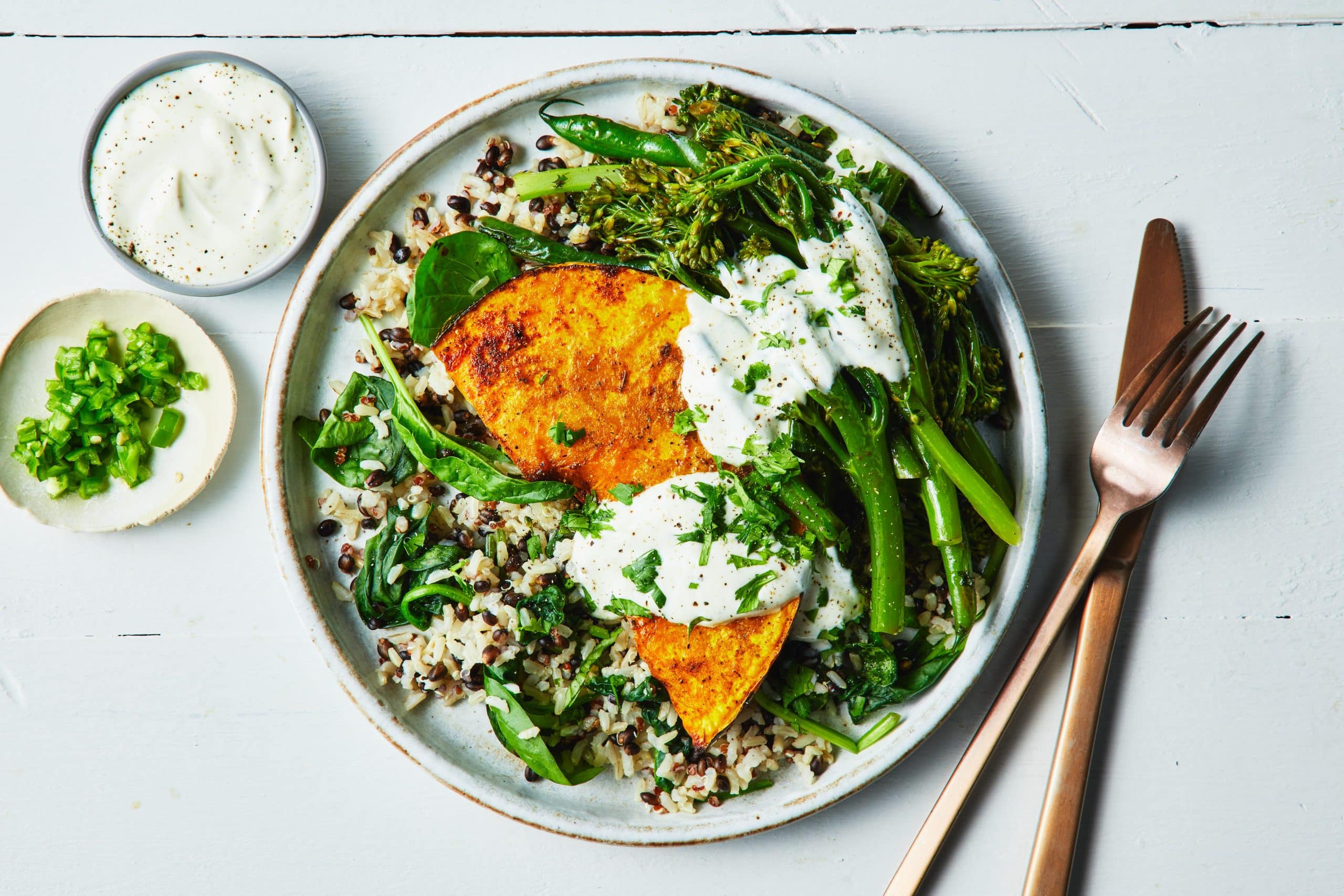Ever wondered what the difference is between simmering and boiling, what it means to emulsify a sauce, or how to easily separate an egg? We’ve compiled our guide to the common terms and techniques referenced in Marley Spoon recipes, to take all the guesswork out of cooking. Have a question about a cooking term that’s not covered below? Send us an email to contact@marleyspoon.com.au and we’ll add it to the list!
A-C
Boiling eggs
Bring a small saucepan of water to the boil. Gently lower the eggs into the boiling water, reduce the heat to medium-high and cook for 6 mins for soft-boiled, or 8 mins for hard-boiled. Drain, then cool in cold water. Peel and use the eggs according to the recipe.
If you have time, remove the eggs from the fridge and bring them to room temperature first. This makes them less likely to crack during cooking but you will need to reduce the cooking time by 1 min.
Bring to the boil
Bringing to the boil means to raise the temperature of a liquid so that fast-moving bubbles break the surface. This is different to simmering (see Simmer below).
Cauliflower ‘rice’
This is raw cauliflower that is finely grated to resemble rice grains. You can use a box grater to coarsely grate cauliflower, including the stem, or you can process roughly chopped cauliflower in a food processor, using the pulse button until it resembles rice. When cooking the ‘rice’, it’s important to use a large pan with maximum surface area so the cauliflower cooks evenly and doesn’t become soggy. We use cauliflower ‘rice’ in reduced-carb dishes as an alternative to other grains like white rice.
Chargrilling
Chargrilling is cooking lean proteins (steak or chicken thigh, for example), certain vegetables and even haloumi cheese using a chargrill pan; these have raised, parallel ridges which create char marks. You can also chargrill on a barbecue. When chargrilling, it is important to coat the meat or vegetables lightly with cooking oil and not oil the pan itself, as the oil will pool between the ridges and will burn and smoke at high heat.
D-J
Deglaze
Deglazing is adding liquid to an empty hot pan over the heat, after removing whatever has cooked, then quickly stirring to help release any caramelised bits stuck on the surface of the pan. You use this liquid to infuse a sauce or dish with extra flavour. Using wine to deglaze adds even more flavour (the alcohol content cooks off in the process). You may need to scrape the bottom of the pan with a spatula or wooden spoon to help lift all the brown caramelised bits during the deglazing process.
Emulsify
Emulsification is a technique used to make much-loved classics such as vinaigrette, béarnaise, hollandaise, mayonnaise or aioli. To emulsify is to force two liquids which don’t ordinarily mix (think oil and vinegar) to combine in a suspension. To help these liquids get along and work as one, you need an emulsifying agent such as egg yolk in mayonnaise or mustard in vinaigrette, plus a good amount of continuous, vigorous whisking to break the oil into tiny droplets that can remain suspended in the solution.
Fan-forced
Most ovens have both fan-forced (convection) and conventional settings. When using the fan-forced setting, a fan circulates the hot air, resulting in a faster cooking time, as well as browning more quickly. At Marley Spoon, we give fan-forced temperatures for all of our recipes. If you are using a conventional setting (or do not have a fan-forced oven), increase the temperature by 20°C to achieve the equivalent fan-forced temperature.
Juicing limes and lemons
We use lemon or lime juice in many of our recipes, mainly in dressings, marinades and sauces. To get the maximum juice, roll the lemon or lime firmly on the bench several times before squeezing to loosen the flesh and make squeezing easier. Limes vary in juice content, so if yours doesn’t yield enough, you can make up the difference with white vinegar.
Julienne
Julienne is a French cooking term for cutting vegetables into short, thin strips, about 6-8cm long and about 1-2mm wide; also known as cutting matchsticks. We often suggest to julienne carrots or other firm vegetables. You can also use a nifty kitchen tool called a julienne peeler to more easily achieve this cutting technique.
K-P
Mandoline
A mandoline is a kitchen utensil with very sharp, adjustable blades and it’s used to thinly and evenly slice vegetables. It can also be called a vegetable slicer. It’s particularly useful when slicing cabbage for dishes such as coleslaw. Always remember to use the guard and be careful of the sharp blades.
Mashing vegetables
The process of using a potato masher (or a fork) to crush vegetables – typically potatoes – to a creamy, smooth consistency. At Marley Spoon, we also make sweet potato, carrot and other root vegetable mashes. The secret to fluffy mash is to start with dry, cooked potatoes; once tender, drain the potatoes well, then return them to the hot pan and shake over low heat for 30 secs to evaporate any excess moisture.
Massaging vegetables
‘Massaging’ might sound strange but it helps to soften tougher vegetables such as kale or cabbage, making them easier to chew and digest. It also allows these vegetables to more easily absorb the dressing or sauce. To massage vegetables, use clean hands to gently rub the dressing or sauce into the vegetables.
Matchsticks (see Julienne)
Also called ‘julienne’, cutting matchsticks is easy and usually used in our recipes for apples and ginger. To do this, thinly slice the apple ‘cheeks’ lengthwise, avoiding the core, stack the slices, then cut into thin strips. The same principle can be applied to ginger.
Mincing garlic
To mince garlic is to crush it to form a paste. It’s important to mince garlic when it’s used raw in things like salad dressings. To mince with a knife, first crush the peeled garlic with the flat slide of the knife, then roughly chop. At this point we suggest adding a little salt to the garlic on the chopping board, as this helps to break it down faster. To mince finely, turn the knife on its side and scrape the blade back and forth over the garlic to form a sticky, smooth paste. A garlic press can also be used and produces a very fine mince.
Pan toasting
This is simply toasting nuts or seeds in a cold, dry frypan until they’re golden brown. Pan-toasting enhances the flavour of nuts and seeds by releasing their oils; it also makes them crunchier. A cold pan is important to ensure the nuts or seeds toast evenly and prevent them burning. Pan-toast in a single layer over medium heat, tossing occasionally and remembering to keep watch; nuts and seeds can burn very quickly. Remove from the pan immediately once toasted, so they do not continue cooking in the residual heat of the pan.
Pasta cooking water
This is the cloudy, starchy water that pasta has been cooked in. Adding starchy cooking water to a pasta sauce helps to not only make a sauce slightly smoother, but also lends body. Tossing the pasta, sauce and a little pasta cooking water together at the end of the recipe helps the sauce coat the pasta.
Peeling ginger
To remove soft ginger skin easily, simply scrape it with the edge of a teaspoon and lift off. You may need to cut off any tough dried ends with a knife first.
Poaching chicken and fish
Poaching is a gentle cooking technique where lean, tender proteins (particularly fish or chicken) are submerged in liquid and cooked over low heat. Chicken or fish should be just covered with liquid and brought to a gentle simmer (see simmer, below). It’s important that the water doesn’t boil, otherwise the chicken or fish will become tough. Remove the chicken or fish from the water once cooked or they may become dry.
Q-U
Removing the skin from fish
Put the fish skin-side down on a board. Using a sharp knife, make a slight incision between the flesh and skin, then holding the skin tightly (use a paper towel for grip), slice between the flesh and skin in a downward motion, angling the blade towards the skin.
Resting meat
Resting meat after cooking allows the natural juices to settle into the meat, ensuring it is tender and juicy. Resting time depends on the size of the cut, however all our recipes advise how long to rest. Put the cooked meat on a warm plate or chopping board for the time specified in the recipe.
Rinsing quinoa
Before cooking, it’s important to rinse quinoa to remove the natural coating called saponin, which can taste bitter or soapy if not removed. To rinse, place quinoa in a fine-mesh strainer, then rinse under cold running water. At first, the water will be white-ish, but keep rinsing until it runs clear, shaking off any excess before cooking.
Roux (pronounced ‘roo’)
A roux is equal parts flour and fat (usually butter) cooked together until a smooth paste forms. We often use a roux to thicken sauces or braises. A roux is also the base of white sauce or bechamel, which uses this simple combination of flour and butter as a base and then, by slowly adding milk while stirring continuously, a silky smooth sauce is created.
Separating eggs
To separate an egg using your hands, gently crack the egg, then catch the yolk in a clean hand, allowing the white to run through your fingers into a small bowl. Gently slide the yolk from your hand into another bowl.
To separate an egg using the egg shells, gently crack the egg and ease the egg shell halves apart with your hands over a bowl. Once the shells are separated, let the yolk settle in one egg shell half. Then gently transfer the egg yolk back and forth between the egg shell halves, allowing the egg white to run off the sides, until all the yolk and white is separated.
Shredding vegetables
Shredding means to cut into long thin strips and should not be confused with making vegetable ribbons. Lettuce and cabbage are best shredded by thinly slicing them with a knife or mandoline (see ‘mandoline’). To shred a carrot, however, it’s easier to use a julienne peeler. Used the same way you use a peeler, the julienne peeler has a teeth-like edge that cuts vegetables into thin strips of varying lengths, depending on the shape of your vegetable.
Simmer
Simmering is when a liquid stays just below boiling point and bubbles gently – the bubbles should form slowly and burst just before reaching the surface. To prevent the liquid fully boiling, the heat should be turned down as soon as bubbles break the surface of the liquid.
Stir-fry
To stir-fry is to quickly cook small, even-sized cuts of meats, tofu or vegetable, stirring or tossing regularly, over high heat. It’s important to have your pan very hot before adding meat, otherwise it can stew slightly and become tough. For large quantities of meat, it is best to cook in batches so the pan stays hot. When stir-frying vegetables, adding a little water to the hot pan as needed creates steam and ensures the vegies cook without burning, or without the need for more oil.
V-Z
Vegetable florets
Florets are the flowering stems that make up the head of a cauliflower or broccoli, however the entire vegetable is edible, including the stem. To prepare, trim the broccoli/cauliflower stem and coarsely chop. Cut the broccoli/cauliflower head into small florets. Try to keep the florets in even sized pieces to ensure they cook at the same speed.
Vegetable ribbons
You can make vegetable ribbons from many vegetables; mainly carrots, zucchini and cucumber. To make the ribbons, trim the ends of the vegetables, then very thinly slice them lengthwise, using a vegetable peeler or mandoline, to create long, thin ribbons.
Zest
The thin, coloured outer peel of lemons, limes and oranges is rich in fruit oils and often used as a flavouring. To remove the zest, lightly grate the peel using a microplane, fine grater or zester; avoid the pith (the white membrane beneath the peel) as it is bitter.



